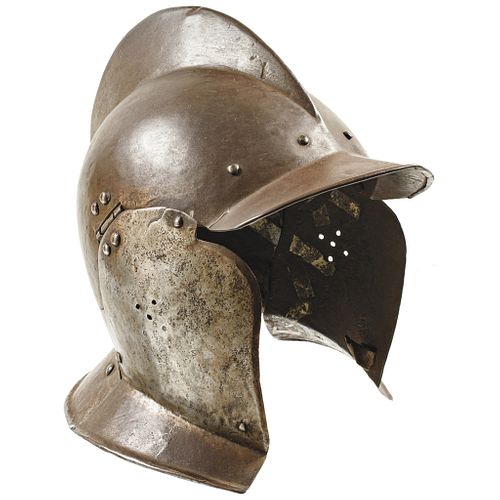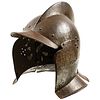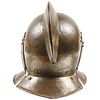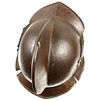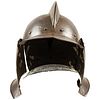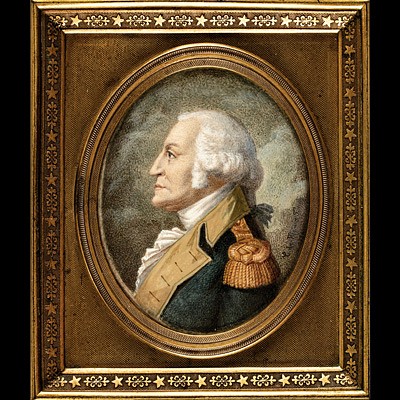Rare Circa 1560 German Burgonet Open Face Helmet Nuremburg
Lot 250
Categories
Estimate:
$2,500 - $3,500
Absentee vs Live bid
Two ways to bid:
- Leave a max absentee bid and the platform will bid on your behalf up to your maximum bid during the live auction.
- Bid live during the auction and your bids will be submitted real-time to the auctioneer.
Bid Increments
| Price | Bid Increment |
|---|---|
| $0 | $10 |
| $200 | $20 |
| $300 | $25 |
| $500 | $50 |
| $1,000 | $100 |
| $2,000 | $200 |
| $3,000 | $250 |
| $5,000 | $500 |
| $10,000 | $1,000 |
| $20,000 | $2,000 |
| $30,000 | $2,500 |
| $50,000 | $5,000 |
| $100,000 | $10,000 |
| $200,000 | $20,000 |
| $300,000 | $25,000 |
| $500,000 | $50,000 |
About Auction
By Early American History Auctions
May 22, 2021
Set Reminder
2021-05-22 12:00:00
2021-05-22 12:00:00
America/New_York
Bidsquare
Bidsquare : Autographs-Colonial-Political-Americana
https://www.bidsquare.com/auctions/early-american-history-auctions/autographs-colonial-political-americana-6913
302 Lots of Rare, Historic Autographs, Americana, Civil War Era, George Washington, Abraham Lincoln, Slavery & Black History, Revolutionary War Era, Colonial America, Federal Period, War of 1812, Colonial Currency, Indian Peace Medals & more... Early American History Auctions auctions@earlyamerican.com
302 Lots of Rare, Historic Autographs, Americana, Civil War Era, George Washington, Abraham Lincoln, Slavery & Black History, Revolutionary War Era, Colonial America, Federal Period, War of 1812, Colonial Currency, Indian Peace Medals & more... Early American History Auctions auctions@earlyamerican.com
- Lot Description
Militaria
Rare Circa 1560 German Burgonet, Helmet Nuremburg
c. 1560, South German Open Face Burgonet (a Renaissance-era and early modern combat helmet), Nuremburg, Used, Choice Fine.
This type of Military Helmet was used throughout Europe in the 16th and 17th centuries and came over with the early European explorers to the Americas. The helmet is designed with a rounded one-piece skull, rising to a high medial top comb (some bruising and areas of delamination), projecting forward to a short obtusely-pointed integral peak. The front (visor) of which is struck with the quality-control mark of the City of Nurenburg (Nuremberg) and an unidentified mark, fitted at its flanged lower edge with a neck-guard of one obtusely-pointed lame at each side. A hinged cheek-piece pierced at its center with five small auditory holes in dice-formation, and flanged outwards at its lower edge to continue the line of the neck-guard. The main edges of this helmet are formed with inward turns, accompanied cheek - pieces by a recessed border. The surfaces exhibit some areas of age delamination, some small dents, small cracks (one contemporary repair made during the period of use) and exhibits overall has a darkening light to deep gray age patina. The inside of the helmet shows a period repair and prior hammer marks throughout. Includes a metal display stand. The inside of this helmet has the number "12" in red paint (possible old arsenal inventory number). There are remnants of old tape residue on the interior that can be removed. A wonderful example.
The burgonet helmet (sometimes called a burgundian sallet) was a Renaissance-era and early modern combat helmet. It was the successor of the sallet. The burgonet helmet is characterised by a skull with a large fixed or hinged peak projecting above the face-opening, and usually an integral, keel-like, crest or comb running from front to rear. Attached to the skull are substantial hinged cheekpieces which usually do not meet at the chin or throat. A flange projects from the lower parts of the skull and cheekpieces to protect the back and sides of the neck. Though typically a relatively light helmet and open faced, a falling buffe, a sort of visor that was closed by being drawn up rather than down, was sometimes used. Some helmets, often termed "close burgonets", were made which took elements, such as the peak, crest and falling buffe, of the burgonet and combined them with the hinged bevor of the close helmet.
Some History Regarding the use of this style of helmet in Colonial America: The early European explorers especially from Spain and England traveled with an assortment of differing styles of armor that was manufactured in many European countries. Remnants of elements of armor has been discovered at many early American Colonial archaeological excavations such as those conducted at Jamestown, Virginia, and various sites in New England.
Our Auction Contents:
Black History & Slavery: (Lots 1 - 63)
Abraham Lincoln Related: (Lots 64 - 74)
Historic Autographs: (Lots 75 - 235)
Colonial America: (Lots 236 - 261)
Revolutionary War: (Lots 262 - 304)
George Washington Related: (Lots 305 - 306)
Early American Guns & Weapons: (Lots 307 - 318) - Shipping Info
-
Early American provides in-house worldwide shipping. Please contact us directly if you have questions about your specific shipping requirements.
-
- Buyer's Premium



 EUR
EUR CAD
CAD AUD
AUD GBP
GBP MXN
MXN HKD
HKD CNY
CNY MYR
MYR SEK
SEK SGD
SGD CHF
CHF THB
THB